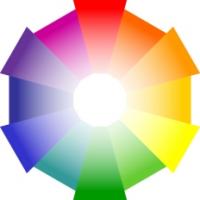Choosing Plant Colours
 Choose planting colour schemes with a colour wheel
Choose planting colour schemes with a colour wheelChoosing plant colours that work well together in the garden can be made simple with the aid of a colour wheel.
A colour wheel is an artist's tool that can be employed by gardeners to help pick colours that create an organised and structured planting scheme. This simple tool can prove invaluable when designing a whole garden or a new border, helping you to achieve a cohesive look and feel.
The typical 12 segment colour wheel is made up from 3 primary colours (red, yellow and blue), 3 secondary colours (orange, green and purple) and 6 tertiary colours.
Different colour schemes for plants can be chosen from the colour wheel following basic colour theory guidelines.
Primary Colours

The three primary colours are red, yellow and blue and are the base colours through which all other colours can be made. Primary colours can not be made by mixing any other colours together.
Secondary Colours

The three secondary colours are orange, green and purple and can be made by mixing any two of the primary colours together. For example, orange is made by mixing the two primary colours red and yellow together.
Tertiary Colours

Tertiary colours can be made by mixing one primary and one secondary colour together. For example, turquoise is made by mixing the primary colour blue and the secondary colour green together.
Complimentary Colours

Complimentary colours are colours directly opposite each other on the colour wheel. For example, blue compliments orange. When used together, complimentary colours enhance each other, e.g. red flowers stand out better against green foliage.
Analogous Colours

Analogous, or adjacent colours are colours that are next to each other on the colour wheel, for example blue, turquoise and green. Analogous colours produce a harmonious, pleasing mix.
Monochromatic

A monochromatic colour is a single colour from the colour wheel, for example green. With a single colour planting scheme, you can use different shades, tints and intensities of your chosen colour for an enhanced effect. A colour lightened by adding white is called a tint, while a colour darkened by adding black is called a shade.
Neutral Colours
Neutral colours are black, white and grey. Sometimes brown, beige and tan are also classed as neutral colours. Neutral colours are good to use as a background to help enhance and accentuate foreground colours.
Filed under Garden Design.
